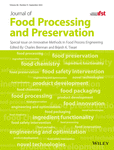A survey on biofilm formation of Lactobacillus rhamnosus (PTCC 1637) and Lactobacillus plantarum (PTCC 1745) as a survival strategy of probiotics against antibiotic in vitro and yogurt
Abstract
Probiotics are useful microorganisms with health effects. Although the probiotic industry has grown dramatically over the past decade, their survival is still challenging. Also, the residual of antibiotics is considered a serious problem with major health and technological problems in the fermented food industry. In this study, the biofilm technique was examined as a practical solution for increasing viability. The biofilm of Lactobacillus rhamnosus and Lactobacillus plantarum are formed in the culture medium (using microtiter plate biofilm method) and yogurt (in containers). The antibiotic susceptibility of probiotics to enrofloxacin, sulfadimidine, tetracycline, and oxytetracycline were studied. The results showed that enrofloxacin, the strongest antibiotic, reduces the bacterial population in the biofilm form only 2.6 log. In contrast, the population of bacteria reduced by about 8 log in plankton form. Therefore, biofilm techniques can be introduced as a survival strategy for the food and pharmaceutical industry.
Practical applications
As a new and innovative approach, the biofilm method can lead to a new generation of probiotics, which can significantly protect probiotics against environmental stress and antibiotic residues and significantly affect their survival. The formation of biofilm by probiotics is a unique feature that is inherently bacterial and is a natural and low-cost method that can upgrade the long-term sustainability of probiotics. Therefore, biofilm can be commercially used to create new capacity in food and related industries.
CONFLICT OF INTEREST
The author declares that there is no conflict of interest that could be perceived as prejudicing the impartiality of the research reported.
Open Research
DATA AVAILABILITY STATEMENT
The data that support the findings of this study are available from the corresponding author upon reasonable request




